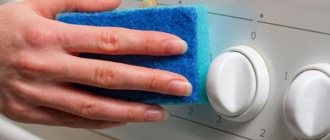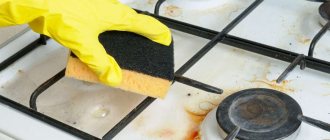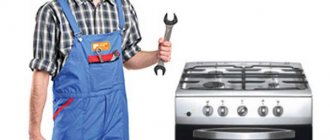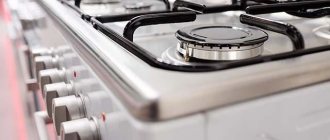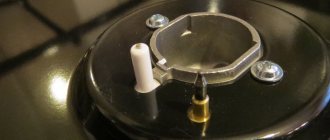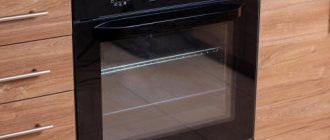Gas stove is a popular kitchen equipment used daily for cooking. It, like any device, needs periodic inspection. Maintenance is necessary to maintain optimal performance of the cooker under heavy use. The regularity of this work guarantees its uninterrupted operation.
Cleaning the stove involves not only surface cleaning of dirt, but also cleaning hard-to-reach places. One of these are the handles, which over time accumulate dirt, dust, splashes of grease, soot, and become clogged, disrupting the normal operation of the gas stove. But cleaning them is often where problems arise most often, isn’t it? After all, users are often faced with the fact that the handles simply cannot be removed. What to do in this situation and how to properly clean hard-to-reach areas?
This is exactly what we will talk about in our article - we will look in detail at how to remove the handles from a gas stove yourself without interfering with the possibility of its further operation. Let's talk about how you can clean dismantled handles and what to do if they are not removable. We will also analyze the design features of the handle and provide a list of the most common breakdowns.
How to remove handles from gas stoves of different models
The operating principle of this technique is almost the same. Plates from well-known manufacturers such as:
- Hephaestus;
- Hansa;
- Darina;
- North;
- Kaiser et al.
Each device is equipped with gas supply power regulators. On some models they are very easy to remove. It is enough to use only the tip of the knife and pry off the element. Other slab models require disassembling almost half of the surface of the structure and the presence of tools such as:
- pliers;
- multi-format screwdrivers;
- kitchen knife.
Removing handles on devices such as Hephaestus, Darina, Hansa does not require the intervention of specialists or contacting service centers. They are simply removable, you can easily clean them and even replace them with new ones yourself. There are gas and electric stoves on which the regulators are welded to the internal parts. Such devices are called stationary, on which it is impossible to remove the handles at home. In this case, you need to turn to professionals.
Regulators on the stove
How to remove handles from a Hephaestus gas stove
Many housewives do not know how to properly remove all the handles from the Hephaestus gas stove in order to wash its surface. The Hephaestus device contains several types of handles responsible for activation:
- main surface burners;
- ovens;
- mechanical timer.
Regulators on the Hephaestus stove
To light the burner, the valve on Hephaestus must be pressed down and turned. As practice shows, removing such regulators is not at all difficult. But you should not forget about the safety rules:
Close the gas supply valve. Make sure all controls are off and turned all the way. Take the knife and pry up the handle
It is very important to do this together with the circle on which the marks are drawn. Apply force and pull up. If the efforts made are not enough and difficulties arise, experts recommend using WD-40 (liquid key). Now you can clean these parts from grease and other contaminants.
Now you can clean these parts from grease and other contaminants.
Removable regulators
How to remove the handles from Darina's gas stove
The regulators of the Darin model are very similar to Hephaestus, in which ignition of the burners requires pressure. Instructions for dismantling parts of this brand are as follows:
First of all, turn off the gas. Next, disconnect the hose that is connected to the device. Check all control valves
Make sure that they are turned off, otherwise it may damage the plastic parts (they may burst). Wrap the regulator with a piece of fabric, pry the edges with a knife and remove it with pliers. Instead of pliers, you can use two knives, where one of them will serve as a lifting lever. You need to remove the rotary handle on devices very carefully so as not to damage fragile components: springs, nozzle washers, cylinder
You need to remove the rotary handle on devices very carefully so as not to damage fragile components: springs, nozzle washers, cylinder
Instead of pliers, you can use two knives, where one of them will serve as a lifting lever. You need to remove the rotary handle on devices very carefully so as not to damage fragile components: springs, nozzle washers, cylinder.
Removing the rotary regulator
How to remove handles from a Hans gas stove
The Hans model is characterized by ease of operation and good performance. As on the two previous kitchen devices, the handles on Hans are removable and do not require much effort. The main thing is to be careful and not forget about safety. Before work, be sure to turn off the gas. The regulators are removed using a small thin screwdriver, with which you need to pry the washer with the adjustment marks and pull it towards you.
Hans gas stove
Usually the process of removing the handles is straightforward, but sometimes fat under the control elements can slow down the process. In such cases, housewives use a variety of soap solutions, which they first wet the parts with, and only then begin to remove the parts. As practice shows, control valves can be easily removed after treatment with liquid wrench. But you should not get carried away with this tool, otherwise it will reduce the performance of the rotating mechanism of the handles.
Internal structure of the stove
Before doing any repairs, you need to understand what a gas stove is, what parts are present in it, and what kind of DIY gas stove repair may be required in a given case.
The structure of the burners
The most noticeable part of any stove is the burners. Each burner is attached to the stove table using bolts. The burner also consists of several parts: they have a lid, a divider and an injector.
Each burner is connected to a steel and copper tube with a fastening similar to the American one. Due to this device, the burner receives gas.
Gas burner device
To work with the burners, you don't need any special tools: you will need a wrench, most likely a size 13, to disassemble the burner parts if it needs repairs or cleaning.
After completing the repair and assembly, you need to assemble the structure and check how tight it is to prevent gas leakage.
Each burner has two candles around its perimeter.
One helps create ignition by working with piezoelectric elements or an electronic circuit, and the second serves as a thermocouple connected to a circuit that controls combustion.
Gas burner (grill removed): 1— nozzle, 2— spark plug, 3— flame sensor (thermocouple hot junction)
The candles differ from each other even in appearance, so it will be difficult to confuse them.
A candle for electric ignition has a ceramic caftan; it is needed to prevent the spark from breaking below the required level.
That is why it is important to properly ground the stoves where electric ignition is built-in. Electric ignition also does not tolerate the use of water pipes and metal threads.
If there is a lot of grease: how to wash a gas stove
For very high-quality cleaning and removal of all dirt, you will have to carry out preparatory preparations.
Hot water poured onto the surface of the stove with baking soda makes it possible to soften old dirt.
Sprinkle baking soda onto a wet surface in an even layer and let it sit for 30-40 minutes. This method is not complicated and allows you to clean the stove and oven. The oven can also be cleaned using this option.
If there is a lot of fat, then it is better to apply a cleanser to it and leave it for a certain period of time, and then wipe it off
After waiting time, we begin cleaning; remove the water and baking soda from the surface of the stove using a soft sponge.
Iron scourers should never be used when cleaning the stove and oven, as they can cause damage to the surface, but it is better to use a sponge and a toothbrush or cotton swabs, but this is in the most difficult to reach places.
To clean the grate on the kitchen stove, you need to use the soap-based solution described above. Citric acid or juice and vinegar are also good auxiliaries. They can be used in place or separately. Ammonia and vinegar can remove dried and burnt-on stains on the surface of your kitchen stove.
All gas stoves are equipped with removable handles.
The main thing here is not to rush, but to act carefully, without rushing and without breaking the plastic.
Stoves from different manufacturers undoubtedly differ from each other. However, from experience, most design solutions from different manufacturers are very, very similar.
Before starting work, turn off the gas supply with the shut-off valve.
Gas panel Hephaestus, Indesit, Electrolux, Darina (knobs that need to be pressed and turned when igniting).
Just pull it towards you at the same time as the ring with the symbols on it.
If you have any difficulties, try treating with WD-40. Then, inserting one knife into the gap between the ring and the handle itself, bend it slightly. And on the other side, use the second knife to act as a lever.
If it doesn’t go through the cloth, use pliers carefully.
Then soak the hands in a mixture of water with a fairy additive. After a certain period of time, the fat will turn white and be wiped off with a toothbrush.
How to lubricate the tight rotating mechanisms of the crane?
The factory lubrication of the faucet is designed to last approximately 5 years. During Soviet times, gas workers used graphite lubricant (called NK-50), LG-Gaz41, LS-1P.
Graphite (crushed carbon), which forms the basis of the lubricant, is able to fill microscopic irregularities in parts, while reducing friction.
It is highly refractory and does not dry for a long time.
You can use solid oil or technical petroleum jelly.
Recommendations for repairing kitchen stoves with your own hands
Instructions for removing the handle
Since most modern cookers have removable power controls, they can be easily removed for cleaning. But, if this has not been done before, then rough oiling can create certain difficulties. Despite this, the cleaning operation is still worth carrying out.
It is important not to forget that the stove is a gas-using equipment, during the operation and maintenance of which it is important to comply with fire safety rules. Therefore, before starting to work with the stove, it is necessary to turn off the gas supply, since any manipulations are considered flammable
Stage #1 - selection of necessary tools
To carry out the work you need to prepare the following:
- gloves;
- gas key;
- pliers;
- screwdriver;
- knife;
- rags;
- water and detergent.
According to safety requirements, work must be carried out with rubber gloves.
Some models of gas stoves have special mounts for handles. You need to remove them carefully so as not to damage the thread and then return them to their place.
A gas wrench, pliers and a screwdriver will be needed to remove the gas stove handle, while a toothbrush and detergent will be needed to clear clogged areas. It is worth remembering that different models of gas stoves have different methods for removing handles.
Stage #2 - dismantling the gas stove handle
You should start working after the gas supply valve is closed.
The gas stove knobs should be set to the “Off” position. In order to remove one handle, you need to pull it towards you and slowly pull it out of the groove. This operation must be carried out very carefully so as not to damage the rotating mechanism.
If you cannot remove the handle manually, you can use pliers
Using the rag as a spacer between the handle and the working surface with part of the pliers, gently squeezing and pulling towards you. In some types of plates, the handles are screwed on with screws; you need to use a screwdriver to unscrew them.
There are also options when you can remove the handle by lifting the mounting protective cap. When using a screwdriver or knife to pry up the handle, you should act extremely carefully so as not to damage the surface of the stove
In some types of stoves, the handles are screwed on with screws; you need to use a screwdriver to unscrew them. There are also options when you can remove the handle by lifting the mounting protective cap. When using a screwdriver or knife to pry up the handle, you should act extremely carefully so as not to damage the surface of the stove.
There are models where the protective ring has grooves, and in order to get it out, you just need to twist the ring a little to the side.
Stage #3 - cleaning removable elements
To clean dismantled handles, you need to prepare a container with warm water and detergent in which to place all removable mechanisms that need cleaning. Keep it in the washing solution for at least 10 minutes, and in case of severe contamination, change the water additionally.
To clean the surface of the handles, do not use substances containing chlorine, as this can damage the enamel coating and erase the inscriptions on the handle.
Using a brush, carefully remove dirt from the areas of the stove where the handles were installed.
Pay special attention to notches, gaps and reliefs
It is worth noting that when processing aluminum parts of the handles, it is better to use a rag moistened with vegetable oil, and then remove any remaining oil with a detergent containing alcohol
Also, when cleaning the surface of the stove and hard-to-reach places under the handles, do not forget about the grate. It also requires timely maintenance.
To effectively clean grates made of various materials, various methods and available means are used.
Detection of failure in models
Like all similar household appliances, a gas stove becomes unusable over time, parts wear out, and repairs become necessary. Each manufacturer's furnaces have their own list of common faults. Most often this concerns problems with burners, electric ignition, and oven doors.
Hansa
Common problems with Hans gas stoves:
- The burners go out immediately after the switch is released. The reason is the adhesion of grease or food residues to the nozzles, a burnt-out thermocouple, damage to the magnetic valve, or faulty electric ignition.
- Unstable fire on the divider. The reason is a clogged nozzle or a misalignment of the air damper, which limits the air supply to the burner.
- No spark in electric ignition. Indicates a faulty fuel control system or worn spark plug.
- The oven door does not close well. The reason is a displacement of the fastening axis or mechanical damage to the door.
- The gas valve is stuck. Most likely, the valve body is damaged, the oil has thickened or dried out, or the locking handle has slipped off the axle rods.
- The smell of butane near the switched off stove. You need to check the connection of the gas pipe to the stove, the pipe itself for any gaps, and inspect the tap.
Darina
Typical malfunctions of Darin gas stoves include:
- random activation of the automatic burner ignition system;
- constant flame during operation;
- turning or sticking of the adjustment knob;
- malfunction of the solenoid valve that turns off the gas supply when the fire goes out;
- When the stove is turned on, there is a smell of fuel, smoke appears, and the flame is orange.
The most common breakdowns typical of Ardo slabs:
Periodic shutdown of the gas burner or lack of ignition. Most likely, the reason is a violation of the spark plug insulation, failure of the thermocouple, solenoid valve, or due to food residues in the injector.
Self-extinguishing burner. The reason is a burnt thermocouple or the need to clean the nozzle or adjust the gas supply.
Difficulty adjusting handles. Usually the problem is solved by washing and cleaning the rotating mechanisms.
Problems with electric ignition
Pay attention to the contacts of the power buttons; they may need to be cleaned. Inspect the unit responsible for supplying the spark, check the voltage in the network
Insufficient combustion
The problem is caused by the need to clean the nozzle.
The smell of gas appears. To determine the cause, they urgently call a technician and ventilate the room, after first shutting off the gas supply pipe.
Ariston
The most common breakdowns in Ariston gas stoves:
- The gas does not ignite. Breakdown of the gas supply valve or electric ignition.
- Electronics malfunctions.
- Uneven burner flame. Indicates that the gas supply is incorrectly configured.
- The burner does not light. Most likely the solenoid valve is not working.
Malfunctions in the operation of the ignition module or igniter are less common; over time, the capillary tube or thermostat becomes damaged, and the burner channels become clogged.
Hephaestus
Common breakdowns of Gefest gas stoves:
- Uneven flame. Eliminated by adjusting the supply of flammable substances.
- Automatic extinguishing of the burner after ignition. The reason is a failed thermocouple.
- No flame. The reason is a malfunction of the Hephaestus model with electric ignition or gas supply tap.
- Malfunction of the electronic module (display, light bulbs, temperature sensors).
Indesit
The following faults are often encountered in Indesit gas stoves:
- An unpleasant odor appears after turning on the burners. It is necessary to clean the burners from food residues.
- The power controls are difficult to turn. The reason is the accumulation of dirt on the mechanism or the decorative handle needs to be replaced due to a faulty faucet fastening.
- Increased combustion. For bottled gas, adjustment of the reducer is required; for a centralized gas line, the reason is a problem with the nozzle.
- Low combustion intensity. It is worth checking the pressure in the system, the condition of the hose, and the nozzle.
- The burner does not light. If there is only one, most likely the divider and nozzle need to be cleaned. If all the burners do not light up, the problem is with the electric ignition.
- The burner smokes during operation. Indicates high pressure in the system, dirty nozzles, deformation of the flame diffuser, low gas quality.
- The oven light does not come on. Most likely, the light bulb has burned out or the contacts have oxidized; also check the serviceability of the socket and network cable.
- Smell of gas when the stove is turned off. It is possible that the device is connected incorrectly to the main line or one of the elements or connections of the structure may be depressurized.
Overview of common faults
If you do not systematically clean the device, there is a high probability of the following problems occurring:
- Difficulty turning the handle . In such a situation, it is worth remembering one rule: using force will only damage the handle. This problem occurs when foreign objects get into the slot between the body and the plug or when a significant amount of dirt accumulates. You can fix the problem by disassembling and cleaning the handle of the gas stove.
- Gas does not flow well into the burner . Even if the knob is turned to maximum, there is a weak fire coming out. The probable cause is that the nozzle holes are clogged with food waste or combustion products. You can fix this problem yourself. To clean you need to use a toothpick. It is also necessary to unscrew the nozzle and wash it with soapy water. Never use metal objects, as even a small scratch can cause a gas leak. But to replace the jet it is better to invite a specialist.
- The tap is difficult to turn . This problem occurs when the graphite grease on the faucet plug is erased and the rotary rod is contaminated. To eliminate it, you need to completely flush the stove tap. To perform this operation, it is better to call a specialist, since it will be necessary to disassemble the front part of the gas stove and unscrew the faucet body, removing the spring and plug from it.
- Rotate the handle 360 degrees . This problem often occurs when using a gas stove for a long time. The reason may be the breakdown of the handle seat. For repairs, you need to purchase and install another handle.
These problems can be eliminated on your own, but if you are not confident in achieving the result on your own, you should call a specialist.
The less frequently the handles are cleaned, the greater the likelihood of problems occurring when turning the handles. Stagnant fat “petrifies” over time, and its cleaning becomes much more difficult
All these difficulties in operation, as well as breakdowns, occur if the gas stove is not maintained. In order not to call a technician to troubleshoot problems, you should take better care of your equipment and perform its maintenance in a timely manner.
If you discover a gas leak or a breakdown of the gas stove, you should immediately call a technician from the gas company with which you have an agreement.
Reasons for poor oven door closing
According to users, incomplete closing of the door is a common failure in gas stove ovens. Frequent malfunctions of the unit are possible due to a clogged nozzle that supplies gas, a broken spark plug, a damaged wire, a stuck power button or a unit associated with electric ignition.
The oven door does not fit tightly due to violations of the operating conditions of the appliance. Often children sit on an open door, and the brackets, unable to withstand such tension, bend and do not press the door leaf tightly enough. In this case, repairing the stove at home will not be difficult. If the reasons lie in problems with the electric ignition apparatus or the operation of the thermocouple, then you should seek help from an electrician or other specialized technician.
Other factors may include loose fasteners and faulty sealing gaskets. In the first case, the fastening needs to be tightened and the gasket replaced with a new one. It is possible to clean the gutter and install the seal after you remove the door from its hinges. Read on to find out how to do this.
How to fix the Hephaestus stove timer?
You can only remove and repair a mechanical timer yourself; with an electronic one, it is better to contact a specialist. The alarm clock mechanism looks like a large metal tablet.
To avoid pouring too much, use machine oil in a special oil can with a thin spout or an ordinary syringe
Try turning the knob to start the timer. Started ticking? This means you can assemble and install in place. No? Try taking it to a watch repair shop, or buy a new one.
Types of pollution
There are a great variety of products for washing household appliances, both professional and traditional. However, the choice of one or another drug directly depends not only on the models of stove regulators, but also on the degree of their contamination.
Light soiling of handles
If you regularly wipe the hob and switches after each cooking, the deposit of grease and soot on the parts will be insignificant and its removal does not require the use of such “strong” drugs as ammonia and others.
ingrained fat
If for some reason the maintenance of household appliances is not carried out regularly, grease and other contaminants accumulate on the surfaces and special methods are needed to remove them.
Conclusions and useful video on the topic
Here are videos that demonstrate the procedure for removing handles from gas stoves of various models.
This video shows how to remove the handles using the Hephaestus gas stove as an example:
The procedure and methods for cleaning handles are demonstrated in this video:
Another way to clean the handles of a gas stove can be seen in this video:
To summarize, it can be noted that cleaning of all elements of a gas stove must be carried out regularly. The main moving element is the handles. They are also susceptible to contamination and may not perform well over time. You must remove them yourself and thoroughly clean them.
It is imperative to adhere to safety precautions when performing work, and also carefully follow the algorithm of actions so as not to damage these elements.
Want to talk about how you removed the handles from your gas stove? Share with other users the difficulties you encountered. Or maybe you would like to recommend an effective product for cleaning handles and stove surfaces that we have not mentioned here? Write your tips and comments in the comments block located below this post.
Article on the topic: Who is the manufacturer of flam gas stoves
Household chemicals
Professional products for the care of household appliances, as a rule, contain various alkalis, acids, surfactants and other components.
The use of such drugs requires compliance with certain precautions during operation:
- Carry out the procedure while protecting your hands with rubber gloves;
- After cleaning, rinse the chemically treated surface several times with clean water;
- There must be a constant flow of fresh air in the room where the procedure is performed, so when starting work, open a window or window.
Which means do you trust more?
FolkHousehold chemicals
The preparations Silit Bang, Sanelit, Mister Proper, the methods of use of which are presented in the table, can effectively clean the stove regulators.
| Name of the product | Mode of application |
| Silit Bang Turbo Power | Turn the spout to the ON position. Apply the product to a sponge and treat the contaminated surface, which must first be moistened with water. After 5-7 minutes, wipe the handles with a rag and rinse them with water several times. If necessary, perform the procedure again. |
| Sanelit Gel | Wet the switches with water and then apply oxygen gel to them. After 15 minutes, rinse off any remaining product and dirt with water and wipe dry. |
| Mister proper | Set the spray nozzle to the "spray" position. The product can be applied in two ways: to treat a large surface area, open the spout flap and press the trigger; for a targeted treatment, leave the spout flap closed and press the trigger. Distribute the preparation evenly on the regulators, after 5 minutes rinse them with water. |
Design and principle of operation
The design of a gas stove from any manufacturer is not much different, with the exception of some features. The oven includes several systems, the operation of which is interconnected:
- Frame. Made of enameled steel, the body is durable and resistant to aggressive influences.
- Working surface. Usually coated with enamel with super-heat-resistant properties. Expensive models contain a stainless steel coating. On top there is an enameled steel or cast iron grate that protects the burners and the entire surface of the stove.
- Burners. The quantity ranges from 2 to 4 pieces depending on the model. Material - from ceramics to aluminum, different sizes. They release gas needed for cooking.
- Oven. Most models of gas stoves have it. Located under the work surface, it occupies a significant part of the entire device. Designed for heat treatment of products: baking, drying, etc.
- Gas equipment. Consists of distribution pipelines, shut-off valves, burners and burners.
- Automatic ignition system. This button, located on the front panel of the case, is needed to ignite the burners, and in some models, also for the grill, without the help of matches or lighters. Allows you to turn on the lighting in the oven.
- Gas supply, control and monitoring module. Has a built-in timer, thermometer, processor, and other devices.
The principle of operation of a gas stove is to use natural gas for heating the home and cooking:
- Gas enters the stove through a tube connected to the supply source. When the substance is supplied from a pressurized cylinder, propane is used as fuel.
- After passing through the burner, the gas reacts with air, turns into a gas-air mixture, which reaches the perforated part of the burner in the upper part, escapes through the dividers and ignites. Cookware placed on the wire rack becomes hot.
- The gas flow is regulated by switches located on the panel.
If the design of the stove is made with high quality, complete combustion of the gas occurs.
Do-it-yourself stove repair
Complete repair of gas stoves Hephaestus, Gorenje and other models requires the intervention of specialists, because... Doing it yourself will not only be difficult, but also dangerous.
However, there are a number of works that can be done with your own hands at home and bring the stove into working condition if its damage is not too serious.
What to do if the electric ignition fails?
The most common problem with gas stoves is the failure of the electric ignition. A video will help you fix this problem - watch it before starting the repair to do everything correctly.
Video instructions for repairing electric ignition using the example of a Gorenje stove:
First of all, you need to disconnect the stove from the power supply, remove the partition from it and inspect it for deformations.
If you see that there are chips and cracks on it, this means that this is why the stove is not working, and the partition should be replaced.
It can only be changed when the ignition or auto-ignition is disabled - do not forget about this. After replacing, check how well it works now.
If your Gorenje stove or another model has a built-in piezo ignition, the operating technology will be slightly different.
First you need to remove the device from the control, then remove the plate partition located below and remove the igniter, which is screwed to the bracket using a fastener.
If it is cracked or otherwise deformed, it should be replaced with a new one. To install a new igniter, you need to disable the module responsible for ignition.
The instructions for the stove will help you find it.
After this, you need to install a new igniter in place of the old part and check how well the gas stove now works.
Oven door repair
Often, after prolonged use, oven doors begin to jam or close poorly.
To carry out similar repairs on gas stoves Indesit, Gorenje and others, you need to unscrew the screws that hold the doors and swing them in different directions so that the door is tightly fixed on the hinges from which it may have fallen off.
After this, re-tighten the bolts, if everything is done correctly, the door should snap into place and the oven should close tightly.
Video instructions for repairing the oven door:
If the part still does not work, then you may need to replace the gasket, which is responsible for sealing the oven door to the stove frame.
To do this, you need to unscrew the door hinges, which are located above the handles, and remove the stove cover.
Most likely, you will also need to remove the internal screws and panel edges, or you can simply move them away and thus remove the cover.
The screws that secure the glass to the panel block must be removed, and then the glass itself must be removed by disconnecting the gaskets that hold it in place.
Now you need to disconnect the gaskets themselves, which are located between the door and the glass from the inside.
Now you need to replace the gasket with a new one and return all the parts to their place, proceeding in the reverse order.
Use the manufacturer's instructions, as... The device of different models will be slightly different, and you will have to act differently.
Adjusting the gas supply to the burner
It often happens that the gas supply to the burner is not adjusted correctly. As a result, the flame burns intermittently or disappears altogether. If the device is working correctly, the flame should be smooth and have a bright blue color.
If your device works differently, then the ignition or auto-ignition needs to be properly configured and adjusted.
To do this, you must first turn off the gas supply and then remove the partition. Then you need to turn it back on and determine which air damper needs adjustment.
To adjust the operation, you need to unscrew the set screw that locks the plate - it is responsible for the proportion in which the gas is mixed with air.
Having installed it in the desired position, turn on the stove and check how it works.
What to do if the electric ignition clicks?
If the clicking sounds irritate or frighten you, simply unplug the stove. Usually a few hours are enough for drying. A more complicated option is to disassemble the electric ignition button and remove moisture. Unfortunately, most types of stoves require removing the lid and quite a thorough disassembly of the gas unit.
Interesting materials:
Is it possible to clean the house on Pokrov? Is it possible to clean on Maundy Thursday before Easter? Is it possible to remove stretch marks on the skin? Is it possible to remove stretch marks on the stomach? Is it possible to remove yellowness from fur? Is it possible to study in the Czech Republic after 9th grade? Is it possible to study at a college and university at the same time in Ukraine? Is it possible to root a sprig of chrysanthemum? Is it possible to cover grapes after rain? Can I eat parsley stems?
Home remedies for cleaning stove handles
Almost everyone knows how to clean grease off stove handles at home using strong household chemicals. But it is not always possible to use such tools, and sometimes they are simply not at hand when they are needed. In such situations, you can easily use improvised means that are guaranteed to be found in every home.
Lemon acid
Lemon acid effectively removes stains on plastic handles. You need to prepare a solution - 2 teaspoons of powder per 1 liter of water. Soak the removed handles in it for half an hour, and then wipe off the softened dirt with a sponge. The main advantage of citric acid is that it not only dissolves fat, but also additionally whitens plastic parts that have faded from intensive use and high temperature.
Important! You must work with citric acid with gloves, otherwise you may get irritation or even a chemical burn to the skin.
Mustard powder
One of the oldest ways to combat grease on any surface is to use mustard powder. It has the ability to quickly and effectively deal with greasy marks, even if they have already dried thoroughly. You can use mustard powder to clean the stove according to the following instructions:
- pour a small amount of boiling water over mustard powder so that you get a thick, mushy mixture;
- rub the slurry over the surface of the stove handles, if they are non-removable, and leave it there for 3-5 minutes;
- rinse with warm water;
- if the handles are easily removed, you can simply soak them in hot water with mustard added, wait until they cool down and rinse well under the tap.
Mustard dissolved in hot water produces acrid fumes that can lead to eye inflammation, sneezing and allergic rhinitis. Therefore, it is advisable to work in a respirator, or it is better to open a window so that everything can be quickly ventilated.
Soda
You should also wear gloves when working with home remedies.
If you don’t have anything to clean the handles of a gas or electric stove from grease at home, you can use soda. Regular baking soda or technical soda, or calcined soda, as it is more often called, will do. The method of use is simple:
In a separate container, prepare a slurry of soda, brewing it with boiling water; Using a sponge or brush, apply the resulting slurry to the surfaces to be cleaned, paying special attention to hard-to-reach, heavily soiled areas; leave the composition for no more than 5 minutes on the surface to be treated; rinse with a sponge and warm water; If the front panel of the stove is dark in color, to avoid streaks, you can wipe it with vinegar after washing off the soda.
Note! It is worth using a mixture of soda brewed with boiling water. If you just use dry powder, it will scratch the surface and make it look dull
Laundry soap
This is a remedy that has been used for many different purposes for many generations. You can also use it to regularly wash grease-covered stove handles. For these purposes, a standard bar of brown laundry soap or a liquid version, which can be purchased today at any household chemicals store, is suitable. Liquid alkaline laundry soap is often found in the household chemicals departments of supermarkets. Instructions for using this product to clean stove handles:
- grate bar soap on a coarse grater;
- dissolve the resulting shavings and bring them to a pulp;
- rub into the surface using a regular dish sponge;
- rinse with warm water after 10 minutes.
Due to the high concentration of alkali, laundry soap quickly dissolves grease. It is absolutely non-toxic and does not cause allergic reactions. But there is one drawback - it has an unpleasant smell, which not everyone likes. It will not work to replace ordinary laundry soap with a scented modern version; it contains 2 times less alkali. Therefore, it is better to simply rinse the surface thoroughly after use and ventilate the kitchen.
How to wash hands in the kitchen?
the handles using a toothbrush
on all sides, rub them thoroughly, and then rinse with water and wipe dry.
Interesting materials:
How many meters are there in one skein of Gamma floss? How many meters are there in one skein of floss? How many meters is the giraffe? How much meat should you give your dog per day? How many milliliters of protein are in one egg? How many milliliters are in 500 grams of flour? How many minutes should I leave the depilatory cream on my face? How many minutes should you keep a self-tanner on? How many minutes a day should you walk on a stepper? How many minutes a day should you exercise on a stepper?
